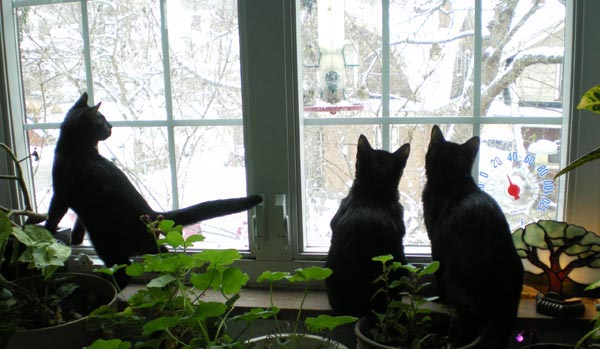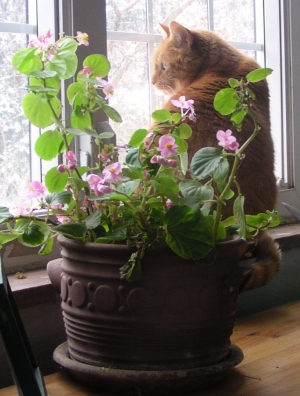Your Backyard Wildlife Habitat: Attract Birds With Homemade Treat Cakes

Among the requirements for my Backyard Wildlife Habitat, I provide food and shelter for native wild bird species all year round because aside from being fun to watch, they are an important insect guard in my vegetable garden.

In winter, however, I am compelled to put feeders up everywhere I can hang one, and at least one seed feeder is visible from each window in the house as well as suet feeders, ear corn and water. Not only does it give the birds a safe place to eat, drink and be merry, it gives my cats something to do and it gives my eyes a break while I slave at the computer all day into the night.
Suet cakes, or something like them, are an important part of the diet for insect-eating wild birds because they provide the birds with appropriate protein. They also provide a medium for mixing in other goodies like nuts and dried fruit and flavoring it with peanut butter or fruit juice. Not only do they feed your regular visitors, but they attract other birds you may not see at your seed feeders, like the parade of woodpeckers who enjoy mine.
I like to spoil my avian visitors—and save a little money in the process, plus use materials that would otherwise be composted or discarded.

Ingredients for your treat cakes
When suet cakes go on sale at my local feed supply store, I stock up, but at other times I put together a dozen treat cakes for about 50 cents each. The goodies I add are fresh or dried apple peelings from pies I’ve made for the holidays, older somewhat tired oranges, other fruits that are past their prime, and the leftovers from making pies and jellies in the summer. I have several mulberry trees and collect crabapples from trees near one of my municipal gardens, and I make jelly with these, as well as baking with the crabapples. As each fruit comes into season—raspberries, blackberries, peaches, plums—I bake or jelly with it, or save the less-than-perfect ones to dry for later use. Birds LOVE these fruit treats in mid-winter. And when I find peanut butter on sale and stand there trying to decide if my birds would prefer smooth or crunchy, I know I’m really in deep.

Suet vs. lard
Suet is actually the hard fat found in cows and sheep, especially from around the kidneys, and for human food use as well as suet cakes for birds it’s rendered by melting, cooking and cooling until it has a consistency like butter.
I use lard, which is rendered pig fat also used in cooking for humans, most famously for pie crusts, but it’s less expensive and easier to work with than suet, so I call the bird cakes I make “treat cakes” instead of “suet cakes” because they don’t contain any suet. Birds get a good dose of protein with either one, but where lard will melt in warmer temperatures, suet will keep its shape and can be used for treat cakes all year round, so I use mine only in the winter.
In the recipe below, you can substitute suet which you would melt and cool, or rendered suet, and these could be used all year.
Recipe for homemade bird treats
- one pound cake of lard
- 8 oz. jar of peanut butter
- one cup of fruit peels or other leftovers, diced
- one cup of regular uncooked oatmeal
- one cup of corn meal
- one cup of bird seed, with more just in case
- several small freeezable containers about the size of your suet feeder
- In a large bowl, mash the lard and peanut butter together, and one by one add the other ingredients mixing until evenly mixed. If the fruit is fresh or you are using fruit juice, the extra liquid may need to be absorbed with extra oatmeal or corn meal. Mixture should be the consistency of cookie dough.
- Press mixture into your containers, and place them in the freezer.
- When you are ready to use them, pop them out of the container and place in your suet feeder.
- Watch your birds have a party.

Some notes and variations
I’ve described mixing the ingredients into the fat at room temperature, but you can also carefully melt the fat and even peanut butter together, then stir in the other ingredients one by one. This was how I initially made my bird treat cakes but I don’t like to work with hot fat if I can help it for safety’s sake, and I really don’t care for the smell of the lard when it’s heated up. But if you do decide to melt your fats for these, then in step one you would use a heavy pot over a very low heat on your stove, slowly melt or even just soften the fats, then proceed with the rest of the recipe. In any case, be extremely careful with hot, melted lard or suet because even just a splash of hot fat can result in a dangerous burn—this taken from the days when I worked standing at a deep fryer at a various restaurants, regularly being splashed as I dumped in the french fries or breaded fish filets.
You can also make these with just lard and bird seed and the birds will still love you. The grain ingredients of oatmeal and corn meal help to keep the fat pliable, and in warmer temperatures absorbs the fat if it softens, making it easier for the birds to eat. You can even use regular flour, but the corn meal or oatmeal have more nutrition.

The fruits add sugar for quick energy and can be used fresh or dried, and you can even add applesauce or bits of jelly. Whole or ground nuts of any sort are also a real treat because the oil in the nuts is also protein-rich.
You can decide for yourself how much you want to spend on the materials. If you buy commercial suet cakes, save the containers and use them to make your own, covering them with plastic or foil for the freezer. Since it doesn’t freeze completely solid, you can make it in a loaf pan and score it before you put it in the freezer or slice it when it’s frozen.
Buying or making a suet feeder
If you don’t have a commercial suet feeder, you can make one out of various materials. A mesh bag from onions or potatoes cut down to size will hold out for at least one winter, unless Fatso the Squirrel gets into it. You can use chicken wire or a product that used to be called “hardware cloth” a 1/4″ wire mesh product. I’ve used various kinds of wire fencing that were generously left behind by previous owners.

And your cats will have plenty of entertainment. For the birds’ sake—and your kitties’—keep them inside, and make sure this is as close to those birds as they get.
Information about feeding birds abounds on the internet. My favorite resources are: The National Audubon Society’s Audubon at Home website; Cornell University’s Project FeederWatch website, which includes not only bird feeding information but also bird identification information plus you can sign up as a citizen scientist and count the birds at your feeders to help track bird populations; and BirdWatcher’s Digest Magazine online where you can read dozens of articles about feeders and feeds and placement and personal experience. These are just the three I reference most frequently, but hundreds of others can teach you more about birds and bird feeding, as can the people you’ll met when you visit the places that sell bird seed and feeders.

After you’ve got your feeders set up, just take an afternoon to sit and observe the birds’s feeding habits. After a while it’s mesmerizing to watch them cycle around with each other. They fly in and out so frequently and hop around so much before they even get one seed that it’s hard to believe they get any nourishment at all from it!
I keep my windows clean so I can photograph the birds (as in the photos above), plus I sketch them, which is a real trick since they never stand still.

Visit the Wildbirds page in my photography gallery to see just a few photos of birds, and in my online Marketplace visit the Originals and Prints Wildlife page or the Notecards Nature and Landscapes or Wildlife page to see some of my art inspired by watching the birds at my feeders. I’ve featured the note cards and notepaper series “Eye on the Sparrow” on my Marketplace blog, as well.
This year I have two series of holiday cards inspired by watching the birds in my backyard, “Greetings From Our Backyard Birds” and “Cardinals Brighten a Snowy Day”. Read about these on my Marketplace blog or find these and more in my Etsy shop.
—————————————
All images and text used on this site are copyrighted to Bernadette E. Kazmarski unless otherwise noted and may not be used in any way without my written permission. Please ask if you are interested in purchasing one as a print, or to use in a print or internet publication.


This is so sweet and a good idea!
Dianda, if you like to watch birds it’s the best way to attract a huge variety.